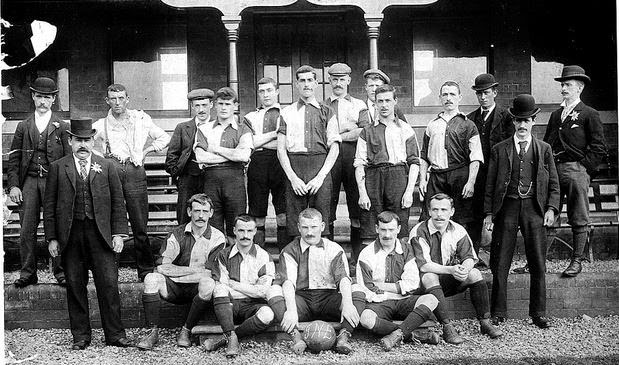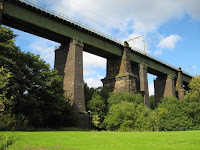Irvine Thornley From Glossop began his
football career with Glossop Villa FC, also playing with Glossop St. James FC,
and then Glossop North End FC in 1901-02 he then went on to join Manchester City FC on 22 April
1904. As his talent blossomed, people loved his personality, he became the Captain of Manchester City and even picked up a cap for the National side. Join us as we delve into the life of another influential Glossop man.
Irvine Thornley was born
1883 in
Whitfield, Glossop, Derbyshire.
After leaving
school he became a butcher. He also played football for several local teams
before joining Glossop in 1901. At the time Glossop was playing in the Second
Division of the Football League. A centre-forward, Thornley scored 42 goals in
79 games for Glossop (now Glossop North End).
According to the 1901 census, Irvine is a tripe dresser, the oldest of three children, now living at 13 Hadfield Place in Whitfield. His father remains a butcher.
On 7th April,
1904, Thornley was transferred to Manchester City for £800. Soon afterwards the
Football Association carried out an investigation into the financial activities
of the club. Tom Maley was interviewed and he admitted that he had followed
what seemed like standard English practice by making additional payments to all
their players. He claimed that if all First Division clubs were investigated,
not four would come out "scatheless".
According to the 1911 census, Irvine is a professional footballer married to Emma. They live at 9 Slatelands Road, still in the Whitfield area of Glossop.
As a result
of their investigation, the Football Association suspended Tom Maley from
football for life. Seventeen players were fined and suspended until January
1907. Billy Gillespie refused to pay his fine and instead emigrated to the
United States.
As Gary James
pointed out in Manchester City: The Complete Record: "Basically, the
entire squad that had finished as FA Cup-winners in 1904 and narrowly missed
out on the Championship two years running were banned. This brought a premature
end to City's first golden age."
 |
| Irvine Thornley From Glossop In his England Strip |
Journalists
were aware that virtually every club in the Football League was making illegal
payments to its players. Football writers based in Manchester argued that the
club, being a northern side, were being made an example of, and thousands of
people complained to the Football Association, but it refused to reduce the
bans and fines.
Harry
Newbould was appointed as the new manager in July 1906. As a result of the bans
and transfers, there were only 11 players available. The first two games in the
1906-07 season resulted in to heavy defeats at the hands of Arsenal (4-1) and
Everton (9-1). Manchester City finished 4th from bottom that season. Thornley
ended up as the club's top scorer with 13 goals in 29 games.
In March,
1907, Thornley won an international cap playing for England against Wales. Also
in the England team that day was Bob Crompton, Colin Veitch, Steve Bloomer and
George Wall whereas Wales included Leigh Roose, Billy Meredith and Billy Jones.
Thornley also played for the Football League against the Scottish League.
Manchester
City finished in 3rd place in the 1907-08 season. However, Manchester United, a
team that included City's former stars, Billy Meredith, Herbert Burgess, Sandy
Turnbull and Jimmy Bannister won the league championship. Once again Thornley
was the club's top scorer with 14 goals in 31 games.
Thornley was
in great form in the 1908-09 season and scored another 18 goals. However, the
rest of the team played badly and Manchester City finished second from bottom
and were relegated.
 |
| Irvine Thornley Cigarette card |
In 1909
Thornley was appointed club captain. He responded well to this new
responsibility and scored 12 goals in the opening 17 games. He was then
seriously injured and missed the rest of the season. Thornley had built the
foundations for a good campaign and by beating Leeds United 3-0 on 23rd
September, 1910, Manchester City guaranteed promotion to the First Division.
Hull City could still deny them the championship but they lost their final game
and City took the title by one point.
Height/Weight: 5'
9", 11st. 0lbs – In 1911 From Manchester City Records
As a reward
for Thornley's service, the club awarded him a benefit. Over 40,000 fans turned
up to the game and Thornley picked up a cheque for £1,036.
In 1912
Thornley was transferred to South Shields. During his time at Manchester City
he had scored 92 goals in 195 appearances.
Player Number: One of four who became the 326th players (327) to appear for EnglandPosition(s)Centre-forwardOnly match No. 90, 18 March 1907, England 1 Wales 1, a British Championship match at Craven Cottage, New Road, Fulham, London, aged 23 years 102 days.Major tournaments: British Championships 1906-07;Distinctions: The only player in the match against Wales not to win another cap.
Thornley
returned to work as a butcher but he continued to play football for South
Shields, Hamilton Academical's and Houghton.
Irvine Thornley From Glossop Died 24 April
1955 at The Ingham Infirmary in South Shields, aged 71
years 139 days
He was living at
10 Aldwych Street in South Shields.
Another true pioneer of sport who not only found fame but had some amazing talent but was a family man at heart. For a man who stood out from the crowd at Glossop to gain national status with Manchester City and to grace the England team he returned to be family man and a butcher. Not many in his shoes in this day and age would to the same.
Complied and edited By M.Cox
References: An English Football Internationalists' Who's Who. Douglas Lamming
(1990)
www.englandfootballonline.com




 More than 20,000 people lined the streets when Frances Lockett returned to Hyde after being crowned the first Cotton Queen of Great Britain. Such was the town’s pride that she was treated like a member of the Royal Family.
More than 20,000 people lined the streets when Frances Lockett returned to Hyde after being crowned the first Cotton Queen of Great Britain. Such was the town’s pride that she was treated like a member of the Royal Family.






















